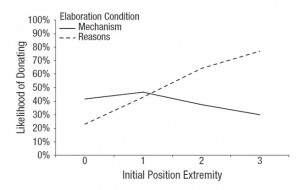Mechanistic Explanation Reduces Political Extremity Among Extremists
Mechanistic Explanation Reduces Political Extremity Among Extremists
1. What They Did – Intervention Summary:
Participants first provided their position on the six policies. They were then assigned to one of four conditions and asked to elaborate on one of two policies: cap and trade or flat tax. Depending on condition, participants were asked either to generate a mechanistic explanation or to enumerate reasons for their position. Next, participants were told that they would receive a bonus payment (20 cents; equal to 20% of their compensation for completing the experiment) and that they had four options for what they could do with this bonus payment. They could (a) donate it to a group that advocated in favor of the issue in question, (b) donate it to a group that advocated against the issue, (c) keep the money for themselves (after answering a few additional questions), or (d) turn it down.
The researchers tried to reduce political extremity by asking participants to elaborate with causal links. In the reason generation condition, participants were asked to write down all the reasons they have for their position on a policy, going from the most important to the least. In the mechanistic explanation condition, participants were asked to describe all the details they know about a policy, going from the first step to the last, and providing the causal connection between the steps.
2. What They Found – Results:
Among participants who initially held a strong position, attempting to generate a mechanistic explanation attenuated their positions, thereby making them less likely to donate. On the other hand, enumerating reasons did not have the same moderating effect as mechanistic explanation.
3. Who Was Studied- Sample:
U.S. residents from MTurk
4. Study Name:
Fernbach et al., 2013, Study 3
5. Citation:
Fernbach, P. M., Rogers, T., Fox, C. R., & Sloman, S. A. (2013). Political extremism is supported by an illusion of understanding. Psychological science, 0956797612464058.
6. Link:
http://www.meteo.mcgill.ca/~huardda/articles/fernbach13.pdf
7. Intervention categories:
generating mechanistic explanation
8. Sample size:
101
9. Central Reported Statistic:
As predicted, there was a significant interaction between initial extremity of policy support and condition, Waldman’s χ2(1) = 6.05, p = .014. At the lowest level of initial support, there was no difference in likelihood of donating between the mechanism and reasons conditions, Waldman’s χ2(1) = 1.78, p > .18, but at the highest level of initial support, participants in the reasons condition were more likely to donate than were those in the mechanism condition, Waldman’s χ2(1) = 6.74, p < .01.

10. Effect Size:
Not reported
Study summary assignments:
Zhang Li
